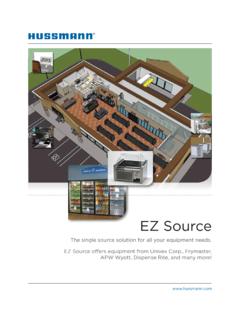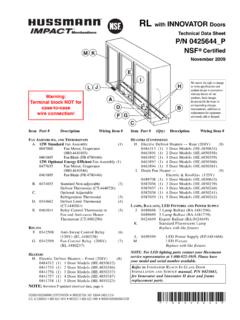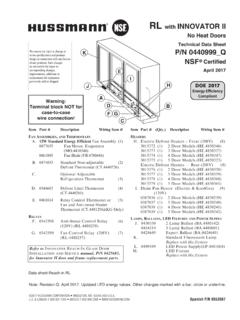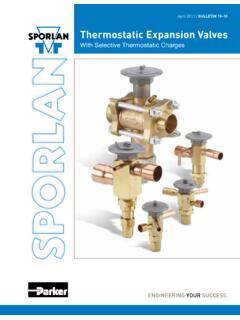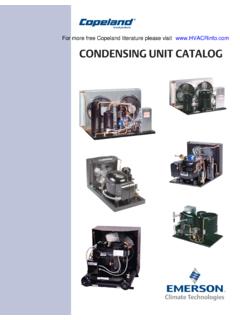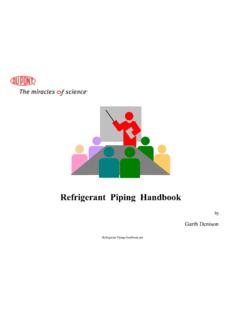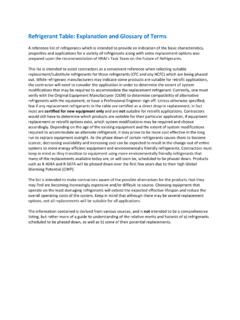Transcription of CO2 Transcritical Systems Training Manual 042718
1 CO2 Transcritical Systems Training Manual Revision 1, April 2018 Table of Contents Introduction .. 4 CO2 as a refrigerant .. 5 - General CO2 Information .. 8 - Environmental Benefits .. 8 - Safety Considerations .. 10 - Asphyxiation .. 10 - Pressure .. 11 - Dry Ice .. 13 - Properties .. 15 - PH Diagram .. 15 - Pressure/Temperature .. 16 - Other Properties .. 16 system Layout .. 18 - Transcritical Booster Systems .. 18 - system Schematic Correlation with PH Diagram .. 20 Hussmann Purity system - Primary system Components .. 23 - Flash Tank .. 24 - Low Temperature Liquid/Suction Heat Exchanger (Optional).
2 24 - Liquid/Suction Heat Exchanger Bypass system (Where Applicable) .. 24 - Electronic Expansion Valves .. 24 - Low Temperature Compressors .. 25 - Evaporators .. 25 - Hot Gas Defrost system .. 25 - Flash Gas Bypass Valve .. 25 - Intermediate Heat Exchangers .. 25 - Medium Temperature Compressors .. 26 - Heat Reclaim .. 26 - Heat Rejection .. 26 - Throttling Valve .. 26 - Oil Management Systems .. 26 - Controls .. 26 - Emergency Back-Up Systems .. 27 - Parallel Compression .. 27 Installation Guidelines .. 28 - Pressure Ratings .. 28 - Piping Materials .. 30 - Brazing .. 31 - Piping Practices .. 31 - Supports.
3 32 - Insulation .. 32 - Relief Valves .. 33 Evacuation and Charging .. 34 - Leak Testing .. 34 - Pressure Testing .. 34 - Evacuation/Charging .. 34 - Oil Charging .. 35 Startup and Maintenance .. 36 - Startup Sequence .. 36 - After Startup .. 37 - Oil Changes .. 37 Appendix A - Hot Gas Defrost .. 39 - Introduction .. 40 - Schematic .. 41 - Hot Gas Defrost - Additional Considerations .. 41 Note: This document is presented for Training purposes only and is subject to change without notice. For additional technical support, please contact the Hussmann Technical Support Center: Hussmann Technical Support Line: 1-800-592-2060.
4 Transcritical CO2 Training Manual I Pg. 4 Introduction Transcritical CO2 refrigeration Systems are gaining acceptance in the supermarket refrigeration industry. National and international policies that originally targeted the reduction of CFCs are being expanded to include HCFCs and HFCs. Technology advancements in CO2 Systems are making these Systems more economically viable, in terms of both equipment and installation cost but also energy and operating costs. The intent of this document is to serve as a Training Manual to support Hussmann s CO2 Transcritical booster system Training . This Training will describe aspects of the design, installation, and operation of these Systems .
5 The current context for this type of system is primarily supermarket refrigeration. CO2 as a refrigerant will be compared to HCFCs such as R-22, and HFCs such as R- 404a and R407a, for the purposes of this Manual . Other HFO blends such as R448a and R449a will also be compared. The content herein is presented with the assumption that users have knowledge of how these refrigerants operate in direct expansion refrigeration Systems . Transcritical CO2 Training Manual I Pg. 5 CO2 as a refrigerant Carbon Dioxide, or CO2, is a naturally occurring compound in Earth s atmosphere. It is the fourth most common atmospheric compound, behind nitrogen, oxygen, and argon.
6 Carbon dioxide is an integral part of the life cycle of plant and animals, as the primary product of respiration in animals and humans, and the primary carbon source for plants via photosynthesis. In recent decades, carbon dioxide has been identified as the most significant greenhouse gas in Earth s atmosphere. It is currently used as the comparative unit of measure when discussing the global warming impacts of various activities, leading to the term carbon footprint. CO2 as a refrigerant has emerged as one of the frontrunners to be the refrigerant of the future. It has the advantages of being environmentally friendly, has good heat transfer properties with a high latent heat of vaporization.
7 CO2 is also non-flammable and non-toxic. The primary disadvantage of CO2 as a refrigerant is relatively high operating pressures. Each of these aspects will be explained as part of this Training . A Transcritical system is defined as a system that operates above the critical point. The following chart shows the PH diagram of R-22, indicating liquid, saturated mixture, and gaseous states. The top of the saturated dome is the critical point. Above this point, the refrigerant is not considered liquid or gas, but an undefined fluid. Transcritical CO2 Training Manual I Pg. 6 CO2 as a refrigerant continued R22 P/H Diagram * Diagram created using REFPROP NIST Reference Fluid Properties As can be seen, the critical point of R-22 is more than 200 F, placing it well above the operating conditions of typical refrigeration Systems .
8 This can be contrasted with the CO2 PH diagram, with a critical point of 88 F. This temperature is often exceeded when ambient air is used as the condensing heat sink. Transcritical CO2 Training Manual I Pg. 7 CO2 as a refrigerant continued CO2 P/H Diagram * Diagram created using REFPROP NIST Reference Fluid Properties Transcritical CO2 Training Manual I Pg. 8 General CO2 Information Environmental Benefits Regulation in the United States regarding refrigerants has been centered on two factors, ozone depletion potential (ODP) and global warming potential (GWP). ODP Ozone Depletion Potential ODP is a measure of the potential of a substance to harm the ozone layer if released into the atmosphere.
9 ODP is a unitless number relative to a reference value, using R-11 as the reference of Substances that have an ODP of zero are considered not to be harmful to the ozone layer. GWP Global Warming Potential GWP measures the potential of a substance to contribute to global warming. GWP quantifies a substance in units of equivalent pounds of CO2. For instance, R- 404a has a GWP of 3940, meaning that the release of one pound of R- 404a has the same global warming effect as the release of 3,940 pounds of CO2. Transcritical CO2 Training Manual I Pg. 9 General CO2 Information continued The table below shows the ODP and GWP of some common refrigerants.
10 Also shown are the safety classifications, per ASHRAE 34. refrigerant Common Name ODP GWP Safety Classification R-111 4660 A1 10800 A1 1760 A1 R-32methylene fluoride 0 677 A2 R-134a0 1300 A1 R-290propane 0 5 A3 R-404A0 3940 A1 R-407A0 1920 A1 R-407C0 1620 A1 R-407F0 1824* A1 3260 A1 R-410A0 1920 A1 R448a 0 1273* A1 R449a 0 1397 A1 R-507A0 3990 A1 R-717ammonia 0 <1 B2 R-744carbon dioxide 0 1 A1 Source: ASHRAE Fundamentals 2017, page *Source: Honeywell Product Literature Source: Linde Product Literature The United States signed the Montreal Protocol in 1987, committing to eliminate the use of ozone depleting substances.




